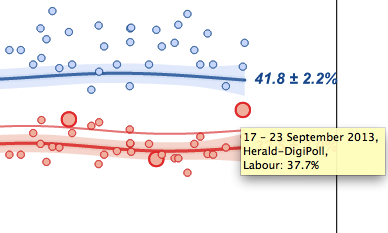Just one poll
A recurring point on StatsChat is that single election polls don’t have a large enough sample size to track short-term changes in opinion. Some form of averaging is necessary.
The excuse for pointing this out again is the Herald-Digipoll result with an increase of 6.8% since the previous poll in June. Since the poll has a 3.6% margin of error for a single estimate, its margin of error for changes is about 5%, so 6.8% is quite impressive.
On the other hand, Danyl Mclauchlan just tweeted a nice interactive plot of aggregrated poll results. I can’t embed it because WordPress is scared of SVG graphics, but the key chunk is here and you can click for the interactive plot
The highlighted points are past Herald-DigiPoll results, and there is indeed a big jump since June, but there’s almost no change since March. This poll seems to have given more variable results for Labour than the other polls do.
The conclusion: it’s too early to tell whether the change of management at Labour has affected opinion. But it’s probably more than a year until the election. We can wait a few weeks for the polls.
[Update: I’m apparently wrong about the excess variability in the Labour results, according to Peter Green on Twitter. Statisticians can overinterpret numbers just as much as the next guy]
[Further update: Twittering establishes that all the obvious suggestions for potentially-better ways to smooth the data have been tried.]
Thomas Lumley (@tslumley) is Professor of Biostatistics at the University of Auckland. His research interests include semiparametric models, survey sampling, statistical computing, foundations of statistics, and whatever methodological problems his medical collaborators come up with. He also blogs at Biased and Inefficient See all posts by Thomas Lumley »

Why does the blue line seem to be consistently below the blue scatters?
12 years ago
I asked about this (for NZ First, the black line). It’s because the lines are basically forced to pass through the election result — that is, any systematic differences between polls close to the election and the actual result are assumed to be bias.
This is pretty much unavoidable, but it causes less of a problem in the USA, where they have a lot of elections.
12 years ago